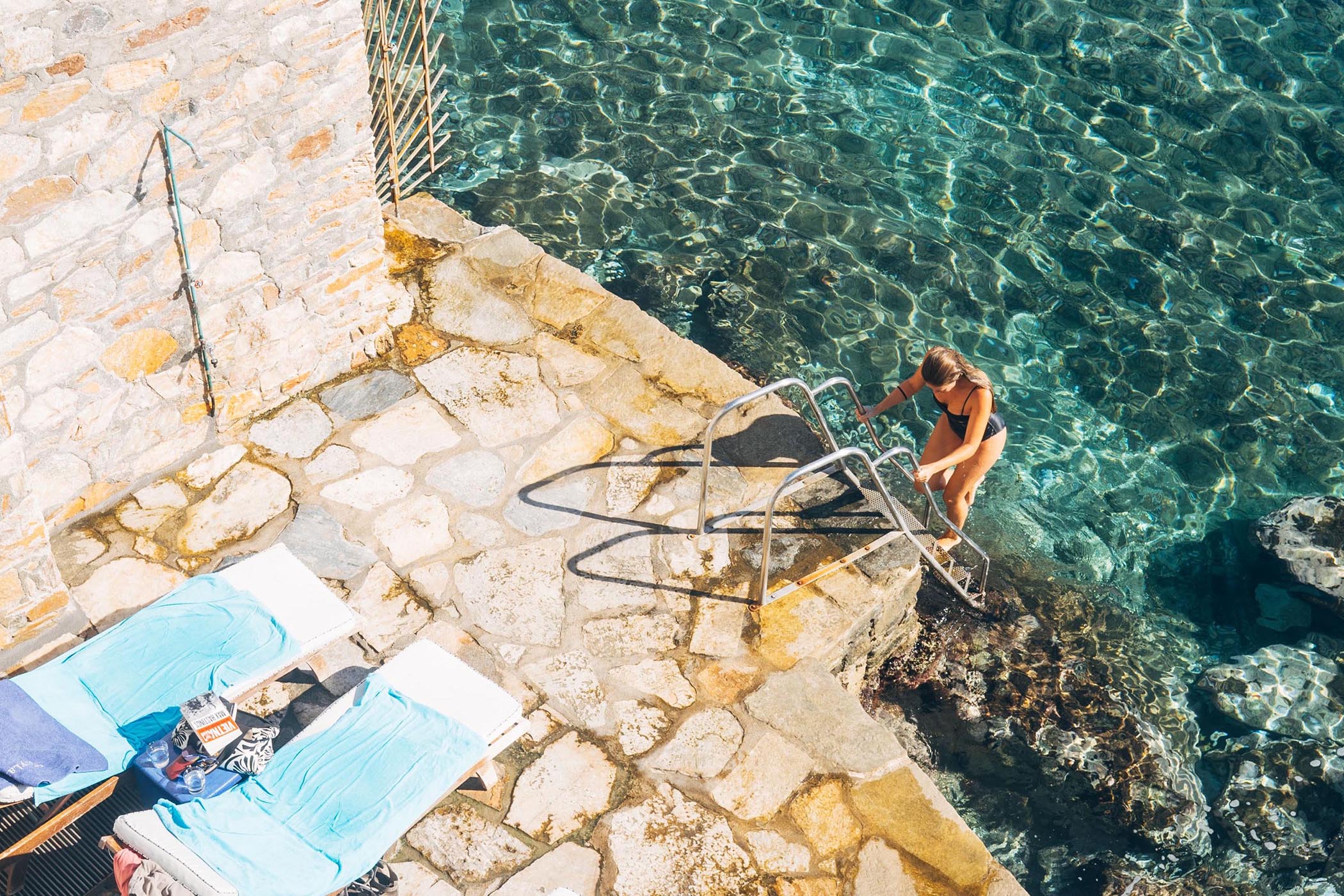Introduction by Anastasia MiariPhotographs by Marco Arguello
Strewn across the Aegean, the Cycladic islands are a picture of Greece as we best know it: whitewashed homes, blue-shuttered windows, dramatic sunsets burning orange into the horizon. Though these islands are geographically at the heart of Greece, not all the Cyclades are made equal. Some have gained popularity for their beauty, others are best known for their beaches, while the most fertile are making a name for themselves in gastronomic circles. What can be agreed is that these days, the best way to see the islands at their finest is to visit out of season.
It’s now that the might of the Meltemi wind has eased, throngs of selfie-stick-toting tourists have gone home and the Cyclades once again belong to locals. By the time “shoulder season” rolls around, even the Athenians return to their jobs and schools, making this the most enticing time for travellers wishing to experience the wild landscapes and quaint villages in their most stripped-back state. Bougainvillea are still in flower. Temperatures for enjoying both beach and adventure activities are ideal. Restaurants ease off on reservations. Life in the Cyclades returns to a more satisfying Greek pace.
Mykonos and Santorini were never my go-to islands to recommend during the summer months, but once the cruise ships and hen parties back off, the inimitable charm of the two most visited islands is restored. Santorini’s astonishing volcanic caldera can finally be seen without tourists snapping from its white walls. In Mykonos, restaurants such as Nolan and La Petite Maison – usually overbooked with impossible queues spilling out into Chora’s narrow cobbled paths – become a realistic option for dinner.
On Syros, the most populated island of the Aegean, the student population returns after a summer hiatus, making this the best destination in the Cyclades for nightlife as the parties on Mykonos wind down. Unlike the islands around it, Syros’s shoulder season is busy with bar openings and the music scene buzzes with DJ sets, such as those held at Boheme del Mar in the pretty port town of Ermoupolis. Meanwhile the rooftop at Hotel Aristide is finally crowd-free for sundowners.
Those wanting to explore the more windswept islands that can be uncomfortable in the breezy summer months can whip around the coastal bends of Tinos, enjoying its beaches free of the community of surfers that descend each summer for its waves. One of the few Greek islands on which roaming donkeys are still a part of the landscape and in which tavernas and kafeneions double up as the proprietor’s living room, Tinos is all the more impressive once its visiting Athenian fans clear out.
Understandably, the islands with no airports are the Cyclades’s most underrated, offering even more solace and a sense of a Greece untouched by the passing of time. Far flung Folegandros’s rust-toned landscape feels otherworldly – more akin to a goat-frequented Mars than planet Earth – while its locals are some of the most welcoming in all of Greece. By October, its sun-scorched wild beaches are almost empty but life still pulsates in its beating heart, white-washed Chora, perched atop craggy cliffs that sink dramatically into the Aegean.
If time is on your hands, take advantage of the islands’ proximity to each other and hop with leisure. Ferry tickets need not be booked months in advance. In true Greek style, you can just see how the mood takes you on the day. The ultimate luxury.
Syros: a real taste of island life. By Rachel Howard
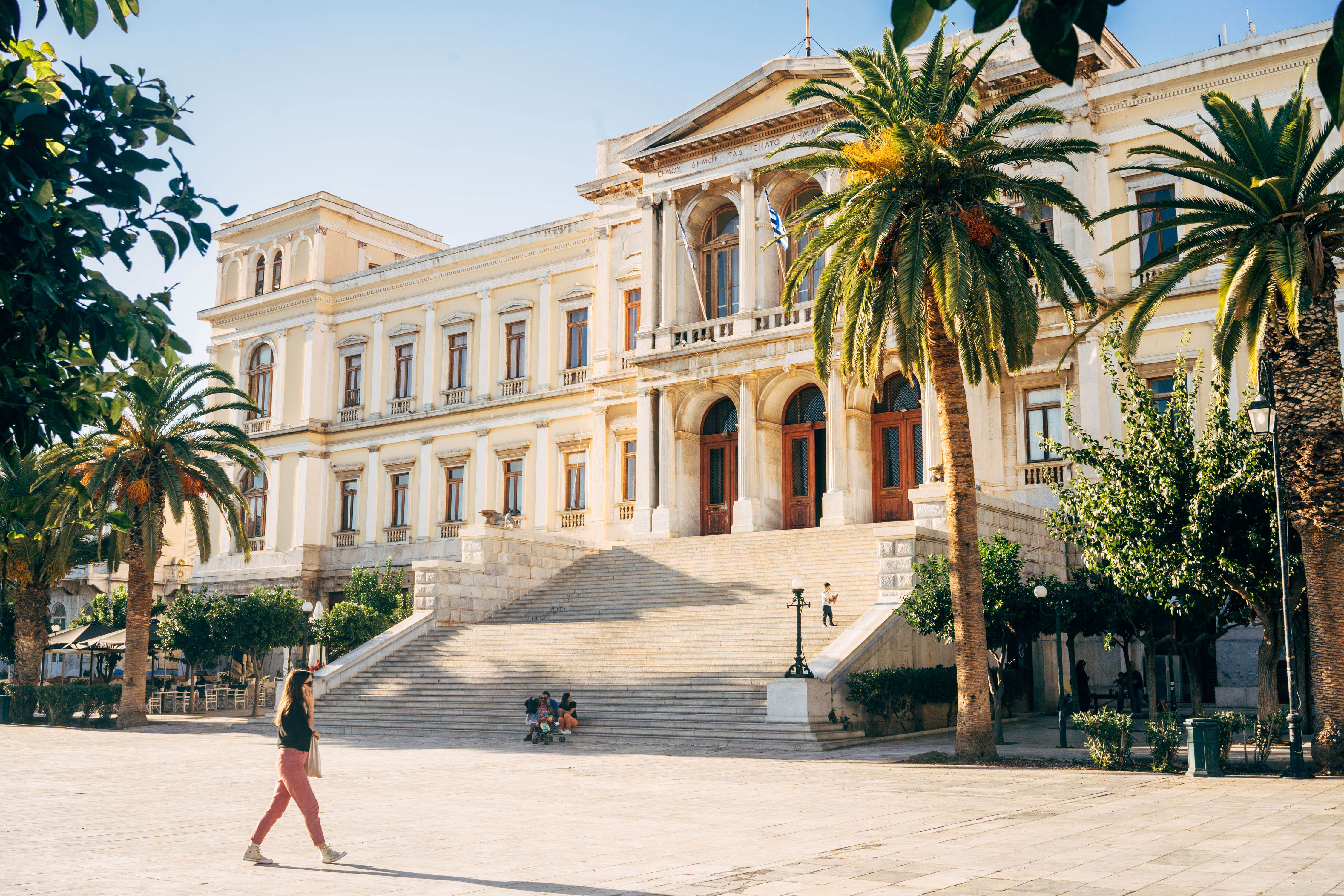
My favourite beach in the world is neither sandy nor pebbly. Technically, Asteria is not a beach at all. It’s two slabs of concrete connected by a short boardwalk where a raft of ducks waddle in unison, leathery old ladies and gents top up their tans year round, and teens in tiny tangas leap into the sea hand-in-hand. Early in the morning, pensioners in frilly hats bob in the water or gossip to a backbeat of Greek ballads on the radio. By late afternoon, every inch of the low seawall is draped in bodies glistening with suntan oil. At Ciel, an up-tempo bar at the far end, big spenders loll on supersized sunbeds and dream of owning one of the magnificent neoclassical mansions that rise from the sea like period fantasies. If all the world’s a stage, Asteria beach on Syros might just be the greatest stage of all.
Like everything else in Ermoupoli, the elegant capital of the Cyclades, Asteria is not what you’d expect. As the ferry pulls into Syros, instead of the typical Cycladic sprinkling of sugar-cube houses, you are met with pastel-coloured palazzos and marble-paved piazzas. Known as the Manchester of the Mediterranean in its 19th-century heyday, Ermoupoli became very, very rich by refusing to take sides during the Greek War of Independence. Bankers and merchants from Asia Minor and the islands of Chios and Psara, close to Turkey, took refuge on Syros and established tanneries, textile factories and a great shipbuilding industry.
Only the shipyard has survived, but the upper crust also invested heavily in the arts, a legacy that is very much alive. Over the years, I’ve seen opera and jazz at the Apollo Theatre, a convincing replica of La Scala. I’ve watched movies in an abandoned quarry at the Syros International Film Festival and listened to rebetiko, the Greek blues, in a boatyard. (Markos Vamvakaris, the godfather of rebetiko, came from Syros). Once I wandered into a chamber music rehearsal in the ballroom of the trade unions association, a magical moment that could not happen on any other Greek island.
Syros defies expectations in the best ways. Tourism has slowly taken off, but it still feels like a real, living island, especially off season, when locals get together for backgammon or impromptu jam sessions in neighbourhood bars. Since it’s the administrative centre of the Cyclades, there have always been plenty of jobs for civil servants and technocrats. Dockworkers and digital nomads, academics and engineering students from the University of the Aegean, and a growing number of artsy expats keep the cafés and restaurants in business all year round.
Unusually, there’s also a large Catholic population, a legacy of the Venetian overlords who ruled the island in the Middle Ages. The Catholics are concentrated in Ano Syros, a medieval lookout with eight fortified gates and stunning views over Ermoupoli. Wandering in the tangle of whitewashed alleys is like stepping into a different island and era. In summer, only fools attempt the stiff climb in the morning heat, but in autumn it’s a bracing way to meet the day. There’s no rush: the delis and ouzeris (like the lovely Maison de Meze) don’t come alive until night falls. After a couple of knockout cocktails at Theosis, a tiny bar whose patrons perch on the surrounding stoops, I hit Hyma kai Tsouvalata, the rocker’s souvlaki joint, where pork skewers are served with a soundtrack of heavy metal.
Although you might be tempted to stay in Ano Syros, lugging suitcases and groceries up the steep, stepped lanes is not as romantic as it might seem. You want to base yourself in the smart waterfront district of Vaporia (the word means ships). This is where those 19th-century tycoons built their mansions, so they could keep an eye on the comings and goings of their merchant vessels. If you don’t own one of those lavish piles, you can make believe at Xenon Apollonos, a three-room guesthouse that stays open through the winter. It’s like stepping into a Merchant Ivory movie – all wicker and wallpaper, lofty stencilled ceilings and vast windows that frame the horizon. A few doors down the street, the five-star Hotel Ploes occupies a grand palazzo with a terrace that seems to float on the water and flagstone steps leading straight into the sea.
There are proper beaches on Syros, of course. Shallow Galissas bay is popular with families. On cloudy autumn days, I go there to eat anchovy “chips” and the finest kakavia (fisherman’s soup, spruced up here with minted mayo) at Iliovasilema (meaning sunset, you can guess why). From Kini Bay, a small boat will deposit you at one of a half-dozen castaway coves on the northwest coast and pick you up a few hours later. Quiet in the summer, you’ll have them all to yourself in the gauzy October light. But really, why bother peeling yourself off the jetty at Asteria? The water is dazzling, the people-watching is unbeatable and the location in Vaporia is perfect. It’s also within walking distance from the ferry dock.
Twenty minutes before my boat is due, I wander through town in my wet swimsuit, stopping for two scoops of pure gelato (smoked hazelnut and honeydew melon) at Django to ease the sweet sorrow of parting.
Tinos: great food and fine escapes. By Anastasia Miari
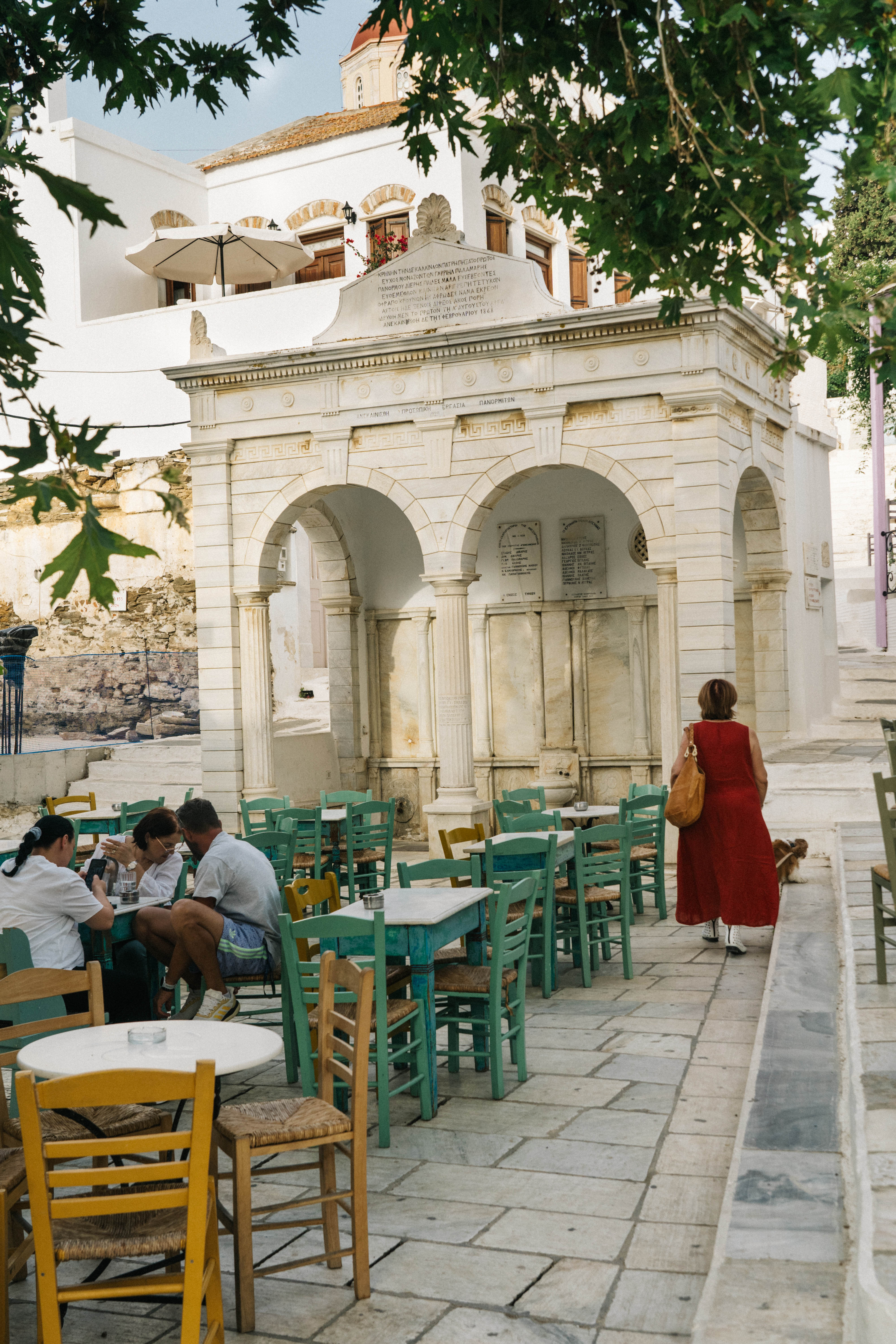
The first time I visited Tinos I thought I might well be blown away. I am not speaking metaphorically. The third largest island in the Cyclades is bashed by the mighty Meltemi, a dry Aegean wind that gives Tinos its wild feeling and rugged landscape. I couldn’t actually sit on the beach that weekend because the wind was so intense that the sand refused to stay put and insisted on swirling up to attack myself and my friends, poised to get into every crevice and our poor, squinting eyes. The beach is not why Tinos drew me back, anyway.
I’ve seen the island in all seasons since my first March visit in 2018. A summer girls’ trip with old university pals, romantic sojourns with my partner, family holidays with our now three-year-old daughter. On each of these visits, I’ve grown to love this wild and wind-bashed place.
Driving around its winding coastal bends and boulder-strewn interior, I’m always magnetised by its drama. Far from the sanitised images of Greece we’re all used to, Tinos off-season is a universe away from the pumping beach bars and bouji boutiques of neighbouring Mykonos, something I’m very grateful for. Sun-scorched in the summer but verdant with acid green foliage and wild flowers in the off-season months, the island is shaped by those visiting winds. Trees bend at obscure right angles, branches outstretch like arms, pointing south. Even the grapevines at Volacus winery on the northeast coast grow sideways rather than upwards. (Tinos has a crisp Assyrtiko to rival Santorini these days),
Forced away from the sea on that first March trip to the island, I marvelled at the amount of animals dotted around its rugged interior. Goats peeked out at me from craggy rocks on roads, donkeys (a rarity these days across the Greek islands) endured my enthusiastic coos and petting. Cows, wild hares and horses completed the terrain while doves flew in their hundreds above me.
I marvelled at the food too, and still do. “We’re very proud of our produce here in Tinos,” Sofia Passa, owner of the Crossroads Inn at Tripotamos village told me as I devoured her cycladic breakfast on the patio. The ingredients were a community effort – sunny-side-up eggs from neighbouring hens, homemade jams made by local yiayiades (grandmas), fresh oranges for juice from Mr Kostas down the road.
Tucked into a labyrinthine village barely visible from the main road, Crossroads Inn is one of many smartly designed village homes-cum-boutique guesthouses on the island. Over the years that I’ve been visiting, lovingly restored properties offer a boutique stay and a sense of remoteness – even during high season. This includes Xinara house, a great example of a traditional Tinian home that has been given a fresh, artistic feel – in this case, with splashes of vibrant yellows and blues – while retaining plenty of original features, in this instance the stonework and wooden beams. Sequestered into a rocky hillside, the entire house can be rented for up to 13 people.
On a more recent visit to the island, I took my toddler to stay at Onos Eco Living, a converted barn near the village of Falatados. The beds are built into the original stone walls and handmade ceramics, stone floors and muted soft furnishings make for a quiet, cosy stay –perfect for afternoon naps. My daughter particularly liked waking up to rogue hedgehogs and hares in the garden. Each of the two suites also has an outdoor courtyard.
What the island is free of is five-star all-inclusives. This has meant that the tips I’ve received for the best ways to experience Tinos come not from oblivious hotel staff imported from Athens, but from locals who truly love the island.
This is how I discovered that gastronomy is Tinos’s USP. “The island is very self-sustaining. We work with people across the generations that continue the agricultural techniques our grandpapas were working with and that’s the beauty of our food,” Vangelis Katsikis, owner at Bianco restaurant told me while I devoured the best taramosalata on the island at its toes-in-sand location to the south.
This year, I wasn’t at all surprised to find a summer outpost of my favourite small plates restaurant in Athens, Svoura, in Komi village on Tinos. Its elegant dishes like scorpionfish yiouvetsi and caper-leaf cod ceviche make so much sense in an island setting.
Thalassaki in the bay of Isternia is memorable for more than just the elevated dishes of esteemed chef Antonia Zarpa (I go back for the ouzo-spiked steamed mussels). On more than one occasion I’ve had sandals and the contents of my bag stolen away by rogue waves that whip their way through the restaurant’s sea-front tables. This doesn’t stop visiting yachts from Mykonos anchoring around the bay for a taste of Zarpa’s now renowned contemporary twist on Tinian fare.
Tereza’s in the village of Myrsini is one of the hot tips I received when staying in Tinos that first, wind-battered March weekend and a place I return to on every trip. Doubling as a convenience store like many island eateries, Tereza’s is a tiny spot set into a geranium-lined garden, serving Greek granny classics like chunky, home-made oregano fries and traditional Tinian fourtalia (a tortilla-like omelette featuring potatoes and Tinian sausage).
Locals become familiar very fast on Tinos. We first met our friend Sotiris at my favourite cafe – O Megalos Kafenes in Pyrgos village – eating a galaktoboureko made by the owner’s mother, Kyria Penelope. Sipping a silty Greek coffee, Sotiris overheard my exclamations of joy as I dipped into the cream-filled phyllo and felt it necessary to explain who had made it. The next minute, my partner and I were in his bashed up Fiat Panda being whisked off down treacherous dirt tracks to visit the nearby marble quarries.
Vast and imposing, the green Tinian marble that I have a slither of in my Athens kitchen is nothing short of majestic when seen up close in the quarries on the northernmost tip of Tinos. It explains why so many artists and creatives have set up on the island, especially in the “marble village” of Pyrgos – a bright white settlement known for its pretty marble triptychs and sleek paving stones that make this one of the most picturesque of Tinos’s villages.
“Tinos attracts so many artists in different fields,” says Virginie Muys, owner of Taxidi, a gallery-cum-boutique-cum cafe which she set up in an escape from the art world of Paris. Married to a Tinian, she chose Tinos as the place to raise her daughter. This makes a lot of sense to me. An easy two-hour ferry ride away from Greece’s capital, with a flourishing food and art scene, Tinos is looking like an island where I too might grow my own family. In fact, I have just bought a house there.
Sifnos: late sun and solitude. By Michael Segalov
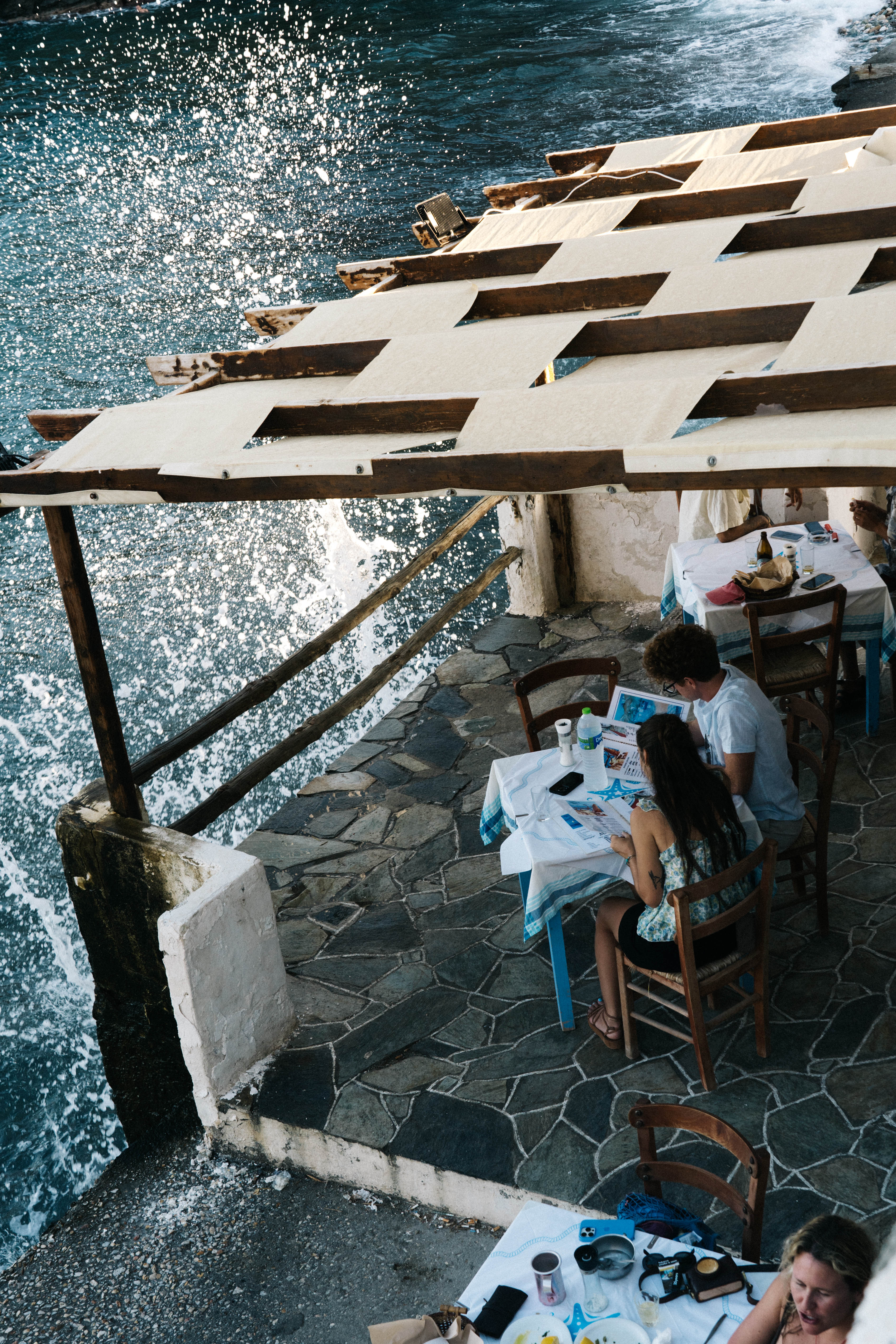
On the first night of my most recent late September pilgrimage to Sifnos, I insisted on taking my small group of friends to dine at Cantina. We parked up on the edge of Kastro, a medieval coastal village, and clambered down to the restaurant - one of the island’s finest - built into the coastal rock. After a quick pre-dinner dip, we climbed the stone staircase that leads to outdoor tables overlooking the pebbled beach. We nabbed a table at 7pm to catch the setting sun and rising moon, then sat back and unfurled.
Here, on this quiet cove, tradition and modernity blend, as is the Sifnos way. Cantina’s kitchen is a restored outhouse, cupboard like in scale, inside which a brigade of young chefs produce a multi-course, locally sourced set menu. The house white wine is a Lefkos produced on neighbouring Paros, visible across the water. Order two, then three bottles, as a stream of delicious plates appear. Few meals, you’ll find yourself repeating at intervals, have felt more special.
For eight years now, I’ve visited the Cyclades for shoulder-season sun: in September, October, sometimes both, to catch the sea while it is still warm, and the islands at their best now that the summer crowds have scattered. Sifnos, I’ve learnt, is that rare thing: an ever-popular destination amongst those in-the-know that retains a consistent, understated magic.
Giorgos Samoilis, Cantina’s head chef and owner, knows why. Formerly a molecular biologist, he spent long summers on Sifnos as a child, before returning to live and work here in his early 30s. “We are a team of restaurants and small hotels building step by step. Sifnos is less vulgar and cash-driven. That show-off, bad vibe, money-throwing crowd has tried to come here - we told them to fuck off. People venture here for refuge.”
It’s something of a mantra here: Maintain Sifnos’s soul; develop slowly and steadily. In 2024, nearby influencer-invaded Milos had 69 permits for new buildings granted approval by authorities; Paros approved 349. In the same year, only 26 were green-lit in Sifnos. That choice is conscious. “If we’re careful,” Samoilis believes, “our identity can offer years of stability and growth.”
It’s a sentiment shared across the island, as is the belief that its traditions are sacred. Communal cooking has been a staple stretching back centuries, and shared wood ovens continue to be fired up in villages across the island, where residents drop their revitha (chickpea stew) and mastelo (lamb or goat with dill and wine) to be slow-cooked overnight in clay pots. Order both at Margarita, a traditional taverna in Artemonas. The service is satisfyingly sluggish - while waiting, scour the large island-wide walking trails map plastered beside the bus stop next door. Despite its humble 74km2 size, the island boasts a network of churches, as is common in the Cyclades, here numbering somewhere between 240 and 360, depending on who you ask. They’re dotted across town centres and remote coastlines; nestled in deep valleys and atop the island’s highest peaks. The 17th century coastal Monastery of Panagia Chrissopigi is particularly picturesque, best seen during an early morning snorkel swim from Apokofto beach. Each is entrusted to a resident or family for upkeep.
There are no sprawling resorts or international chains. Stay instead in one of the many boutique accommodation offerings. Sigma Residences is a collection of 11 self-contained houses built in local green stone with serene views across both arid valley and ocean. (Seaview rooms for this October can still be snapped up for £125 on their website, breakfast basket included). When Gregory Skalistiras opened Sigma in June 2023, he became the custodian of Agios Ioannis: a humble, white-washed chapel over which he keeps watch on the property’s periphery.
The most recent on-site addition is Mythic Villa – a perfectly appointed retreat, tucked away from the other guest rooms with its own private infinity pool. Rooms can be sectioned off, or booked whole to sleep 12 across six double bedrooms.
It’s the perfect point from which to explore. Take the well-trodden trail from its doorstep first down to Kastro, then north along the coast to Panagia Poulati, a beautiful blue-domed church, and jump into the crystalline Aegean. Dine alfresco at Cafe Mosaic, a beloved, intimate courtyard restaurant popular with locals and visitors alike. Stroll around the ruins of the Mycenaean Acropolis of Aghios Andreas for a dose of local history. March up and down the snaking stairs at the Church of the Seven Martyrs, before nosing around Vryssi Monastery, where the white-haired priest – Sifnos’s most senior – resides with his mother.
It’s a bumpy drive down to Atsonios ceramics, a family-owned pottery studio. By October, ransacked summer season shelves are starting to be replenished. In the family since 1870, Atsonios encapsulates the old-meets-new Sifnos spirit: contemporary glazed dinnerware sits alongside pieces produced in the 19th century. As Yiannis, the fourth generation potter puts it: “People here have kept their way of life and beliefs alive.”
Nowhere feels busy on Sifnos at this time of year, but its capital – Apollonia - sustains a buzzy charm. Potter along its winding pedestrianised thoroughfare with a supply of local almond butter biscuits from bakery To Stavri. Later, order cocktails at Doloma Bar, nab a dimly lit alleyway table, and surrender to island life. The north of the island is rugged and sparse, the end of the road marked by the small fishing village of Cherronisos. From here, it’s barely a one kilometre walk to Agios Georgios, a hilltop church - the island's most northerly outpost - where the well-informed flock for sunset. Midsummer heat can turn the short ascent on-foot into an exhausting expedition, but by late September, temperatures are more forgiving in the relative cool of golden hour.
On last month’s visit, it was a hike I had every intention of undertaking. Only, we lost track of time during a heady afternoon of sea-swimming and beer-sipping. With daylight dwindling and walking plans abandoned, our hire car reluctantly trudged up the track. We joined a handful of older Sifnosians. As the sun, hovering above the horizon, drenched the ocean and island vistas in pastel hues, I was already planning my next trip back.
You can travel from Athens to Sifnos in just 2.30 hours with Seajets [seajets.com]
Kimolos: lost in time and space. By Heidi Fuller-Love

At just over 20 square miles in size and with only one main road that runs for roughly 10 miles, Kimolos is the smallest of the Cycladic islands. A 15-minute ferry hop from its sister island, Milos, time – and tourists – have largely passed it by.
I first found Kimolos, named for the kimolia, or chalk, which has been mined here since antiquity, when I was backpacking between the islands 25 years ago. Back then, its putty-coloured slopes were home to around 800 inhabitants; today that figure has increased only very slightly… to 810. It was, and still is, a tight-knit community, with fishing very much a part of everyday life. Creamy kakavia fish soup and fish-based tomato and orzo giouvetsi, or casserole, remain staples to this day.
Back then, even compared to the other Cyclades islands, all far less developed than they are today, Kimolos was in a world of its own. Each time I have returned since, I have expected the island to be under siege from new hotels or assailed by trendy restaurants serving “reinvented Greek cuisine”. Perhaps because it doesn’t have an airport, this volcanic island, which is also known as Schinoussa, or Island of Sea Urchins, thanks to its abundant marine life, has remained almost the same as it was when I first visited. (It helps that Kimolos is a up to an eight-hour ferry trip from Athens, or a five-hour trip by catamaran.) I still got my fresh fish fix at Kalamitsi, a taverna on the beach, and Lostromos, one of the island’s oldest tavernas on Psathi’s tiny port, still serves the best iced café frappe in the archipelago.
Admittedly a few of the old fishermen’s cave houses in the tiny villages of Goupa and Karra have been converted into luxurious rooms to let, but Dekka beach, where I once camped for days in the soft sand, remains a peaceful spot. So is Ellenika, a narrow, near-deserted beach – from here, you can snorkel out to see the submerged ruins of an ancient Mycean city. If I am feeling more energetic, I’ll hike the 20 minutes from the island’s capital, Chorio, along a trail littered with prickly pear and crumbled dry-stone walls to see Skiadi, the island’s most famous rock formation. It looks like a massive girolle mushroom.
Over the years, I’ve usually stayed in domatia (rooms), but recently I’ve discovered the island’s revamped syrmata. These boat-sized cabins, which were named for the cables (syrmata) that were used to haul the boats up from the sea, have been repurposed as unique accommodation. Traditionally used to store the island’s authentic kaiki fishing boats during Kimolos’s wild, wet winters, they’re right by the water, which means you step out from your room on to your own private beach.
On my last visit, I stayed at Thalassa Beach House. The syrmata was just one narrow room with a low, timbered ceiling, plump bed set on a dais, small fridge and gas ring to heat food. A faint aroma of seaweed and warm wood hung in the air. I’d sling off my shoes and crunch barefoot across the beach’s shell-strewn sand to spend the afternoon snorkelling, or lazing in my cabana, which stood, throne-like, in the middle of the beach. Crime is unheard of on Greece’s more remote islands, so I felt safe at night as the wind wailed outside, and the sea sighed along the seashore – it was like being in a boat.
There are several ways to get around this compact island: you can catch the lumbering green bus, book Mrs Logothetis’s taxi, or ride the waves in a Delfini sea taxi. This time, I hired a moped from Kimolos Moto. First, I headed for Chorio, the island’s only real town. Sprawled over the windmill-studded flanks of Mount Xaplovouni, Chorio is a whorl of cobbled alleys and whitewashed houses winding around the crumbled ruins of Kastro Kimolou, a medieval castle and settlement. On a couple of evenings I puttered over to the fishing hamlet of Goupa, where creamy cliffs and blue-trimmed syrmata form the backdrop for Cine Kalisperitis, a tiny outdoor cinema named after the local word for the evening star.
I’ve built up a list of favourite local tavernas over the years, including Kali Kardia in Chorio, where wood-oven-baked kleftiko (goat) pairs perfectly with a carafe of the owner’s red wine, or Bonatsa on the beach of the same name, where freshly caught sole is grilled and served with nothing more than a squirt of lemon juice. The views across to the uninhabited island of Polyaigos are spectacular.
If I am going to a beach, I will stock up with a few slices of ladenia, the local onion-topped version of pizza, kolokythopita (sweet pumpkin pie) and a bottle of crisp white Spilia Assyrtiko wine, which comes from Milos. For a choice of beach, I avoid Prassa, despite its white sand and turquoise seas, as it attracts daytrippers. I prefer quieter Alyki, with its shingle and sand strand shaded by tamarisk trees, or Agioklima, which has hot springs that bubble out into the sea.
Andros: hilly hikes and mule tracks. By Imogen Lepere
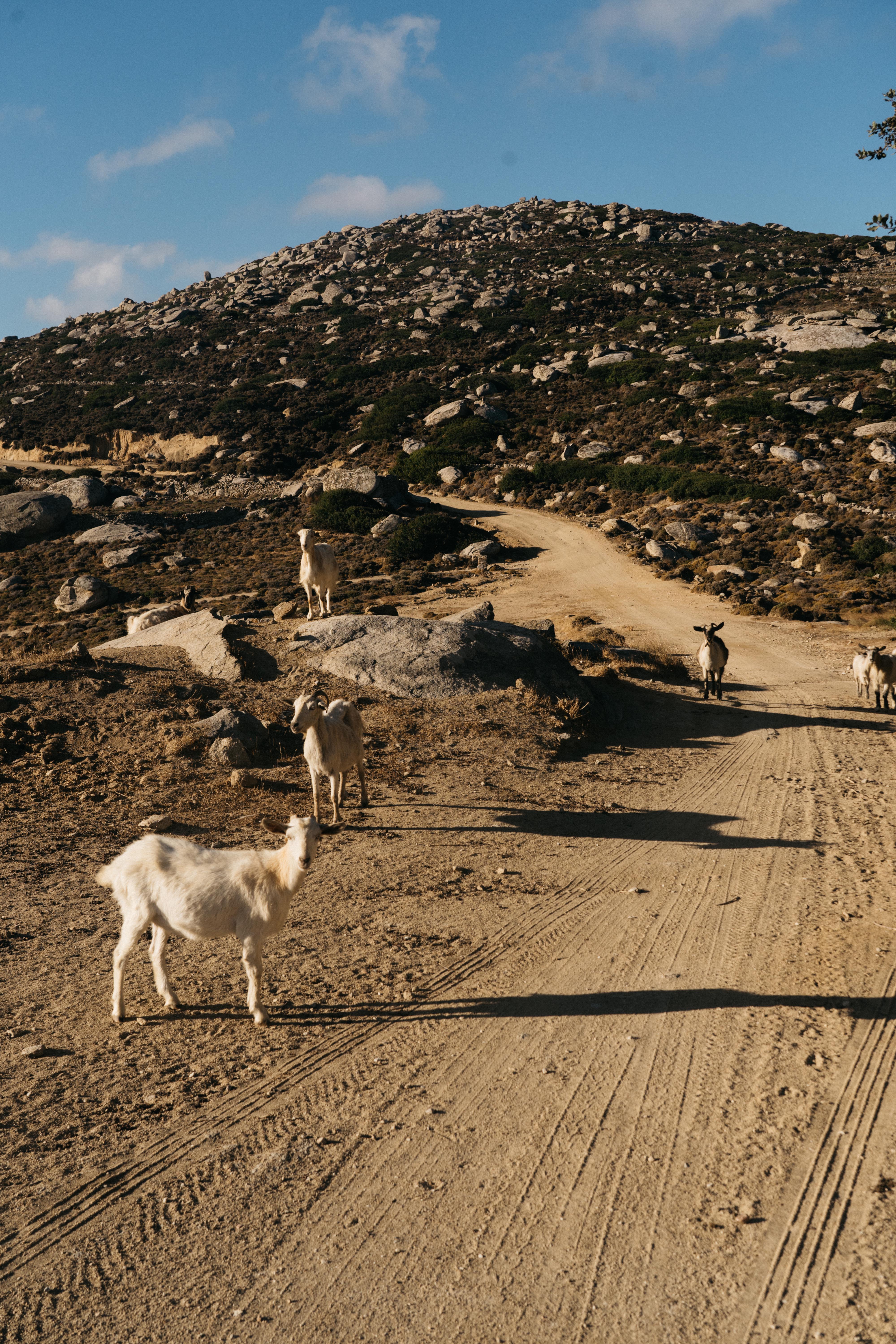
It was two o’clock by the time I located environmentalist Alexandros Mavis’s house in the mountain hamlet of Katakelei on the island of Andros. Mavis, unperturbed by my timing, was busy cooking fricassee. “I’ve been living without clocks for 25 years and lost track of time,” he said, handing me a black coffee.
I’ve visited 18 Cycladic islands in a love affair with Greece that started when I was a teenager, but there’s something special about Andros, the most northern and second largest in the Cycladic group. “Losing track of time,” could be its unofficial motto.
Although it has more than 70 beaches, from raw Vitali in the north to Chryssi Ammos in the cosmopolitan west, Andros’s timewarp magic is most intense inland, where historic villages, such as Menites, are home to the likes of Drosia taverna. Visiting the island to hike a few of its many trails, I lingered at Drosia, enjoying its fourtalia (the island’s spearmint sausage omelette) with draughts of icy fresh water from the spring in the village square.
For me, Andros’s main draw is the network of ancient mule tracks – some of which date back more than 800 years – which the volunteer-run organisation Andros Routes has been reimagining as hiking trails since 2012.
“Some of the villagers you meet along the routes are the last of the Mohicans,” says Mavis, who has been involved in the project since its inception. “They are doing things as they have been done for more than 3,000 years.” In October, when the mercury hovers at a balmy 21C, the trails are empty except for the winged insects who use the dry stone walls to protect them from the wind as they travel between Andros’s many farms.
Bolstered by Mavis’s strong coffee and with instructions provided by my hosts, the hiking tour operator Ramble Worldwide, I set out on Route 3, the six-mile trek from whitewashed Ormos to Chora, the island’s unexpectedly grand capital. The gentle route stretches through fertile valleys peppered with beehives and windmills, although there are one or two descents steep enough that locals have hewn steps into the hillside.
As I descended into the Dipotamata ravine, Spanish broom scented the air. My footsteps startled a family of milk-white goats, who leapt from terrace to terrace. In the deep afternoon, an elderly lady invited me to rest in the shade of her father’s lemon trees and offered me a spoonful of syrupy damask rose petals, one of the island’s traditional sweets.
I arrived in Chora when the evening sun was gilding the neoclassical mansions that have been passed down by major shipping families since the 1800s. Athens is just two hours away by boat, and a cosmopolitan cognoscenti had finished browsing the Museum of Contemporary Art and was now gathering outside Endochora, a smart little bistro serving natural wine alongside grilled fish.
I was enjoying out-of-time Andros and didn’t yet feel ready to rejoin 2025, so I continued walking to the old port where Archipelagos Andros still has the paper tablecloths and glass counters my mother recalls from the Greek tavernas she – like Joni Mitchell – frequented in the 70s.
I spent hours listening to the clacking of backgammon chips, the taste of imam (aubergine stuffed with onions and garlic) and the salt of the Aegean clinging to my tongue. I thought about how, next year, I’d love to return and walk the full Andros Route, a continuous, 100km path from the Frousei valley in the north to Dipotamata in the south, perhaps spending a night at Oak Farm Andros, a rustic stone cottage on a family-run farm in the seaview-village of Fallika. On Andros you walk in the footsteps of generations of islanders. Losing track of time is easy – and I can’t think of a more transportative feeling than that.
Inside story: how to make the most of the islands from those who the know
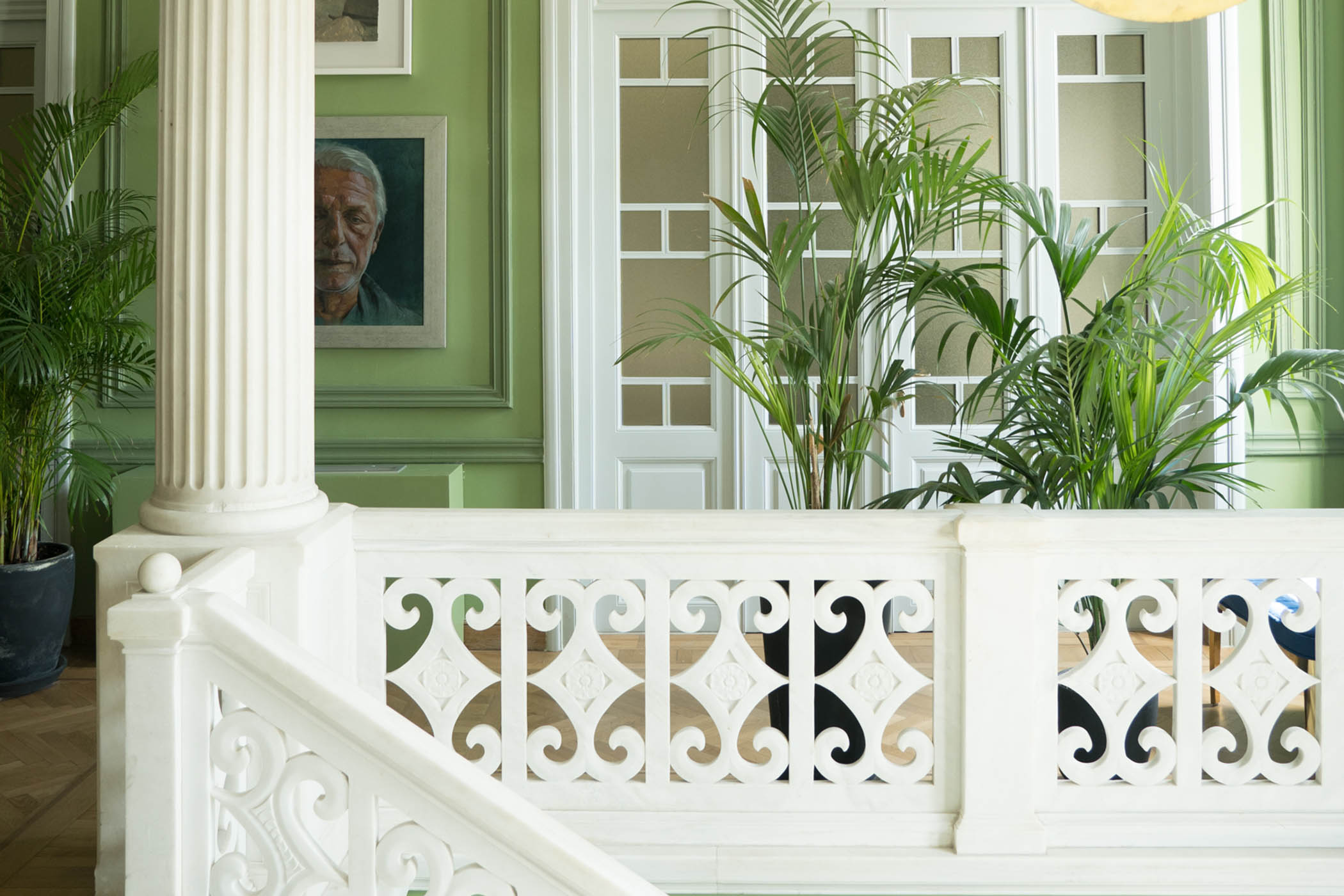
Five best places to stay: Rachel Howard shares her favourite independent spots in the Cyclades
Ayiopetra, Naxos
With tiered terraces, a huge pool and ever-ready service, it’s hard to believe there are just five suites at this serene hotel in the Sagri valley. Decorated and managed with flair by mother and son Tonia and Dimitris, the five-course breakfast includes seasonal treats such as fig tart, pressed grape juice, courgette and feta omelette (ayiopetra.com).
Under the Linden Tree, Tinos
Beautifully restored and decorated with vintage textiles and modern art, these five stone cottages are surrounded by olive and orange groves, vineyards and freshwater springs in the peaceful heartland of Tinos. It’s a sublime setting for yoga retreats or simply surrendering to nature (underthelindentree.com).
The Rooster, Antiparos
Overlooking wild, windswept Livada beach, the 16 stone villas at this stealth-luxe retreat vanish into the landscape. Everything feels natural and pure: feelgood food (and fantastic sourdough bread) from the hotel’s farm, botanical cocktails at the sunset bar and an amazing ayurvedic spa (theroosterantiparos.com).
Gitonia tis Irinis, Koufonisia
The essence of Cycladic simplicity: 15 modest blue-and-white rooms clustered around a courtyard shaded by flourishes of bougainvillea. All just a few barefoot steps from the sea (koufonisia-diakopes.gr).
Skinopi Lodge, Milos
At the end of a dirt track, perched above the tiny fishing village of Skinopi, an autumn visit beckons with dawn dips from sun-baked rocks, alfresco lunches cooked in a wood-fired oven, boat-watching and sunset worshipping in fields of wild herbs. This level of privacy, serenity and unadulterated beauty comes at a price, but you won’t begrudge a penny (skinopi.com).
Where the locals go: Rachel Howard hears from five insiders
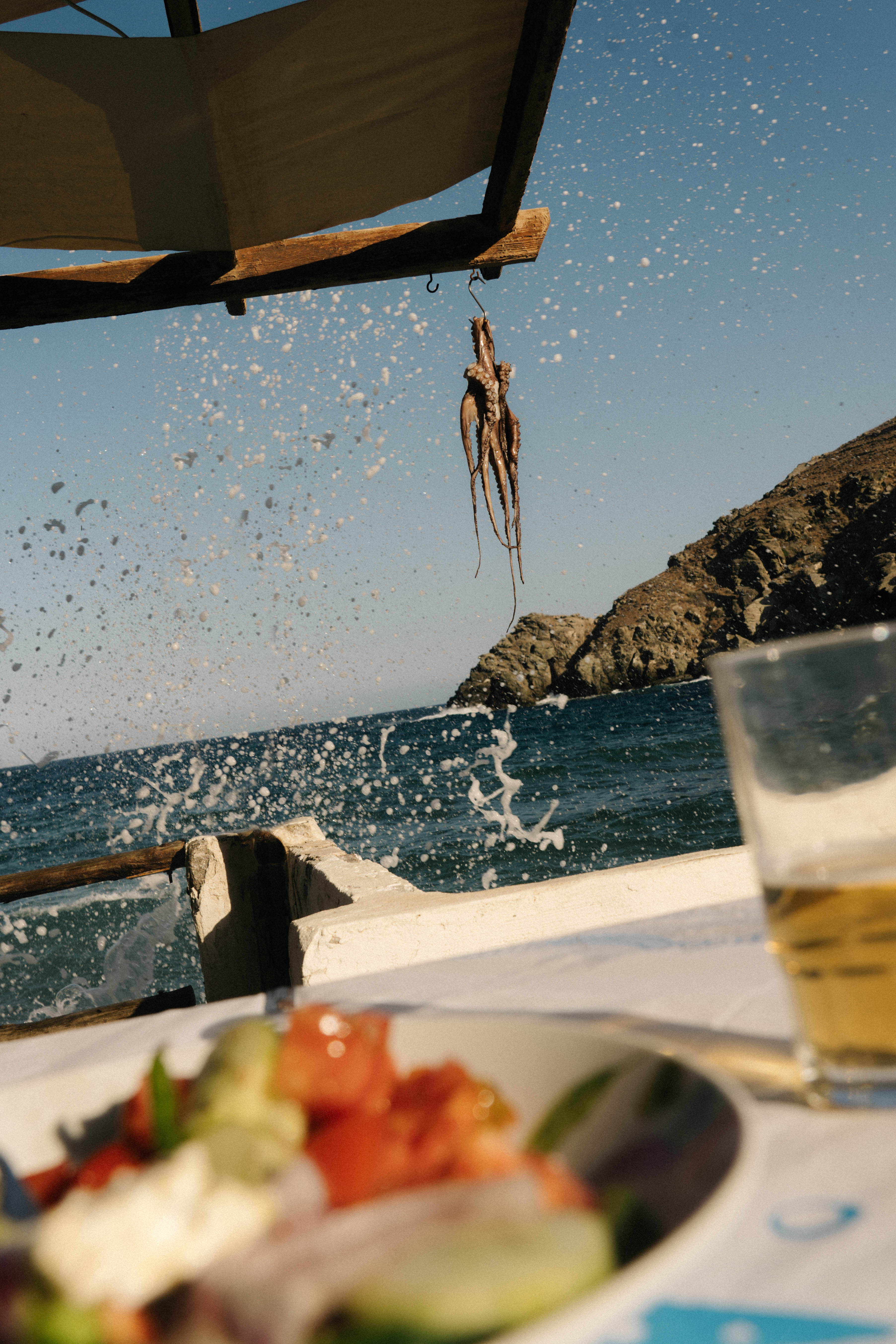
Naxos secrets by Giorgos Korres
“My island, Naxos, isn’t fancy. It’s very untouched. The best beach is Psili Ammos and the most beautiful villages are Apiranthos and Sagri. Walk around Kastro then have cocktails at Belman bar. The best taverna is Vasilarakiou in Kinidaros. For authentic souvlaki, go to Karavasiolios in Filoti. Don’t forget to visit Portara at sunset, followed by a romantic dinner at the Naxos Apothecary.” Giorgos Korres is founder of cosmetics brand Korres
The green gorges of Andros by Jacob Moe
“Autumn is ideal for exploring the network of community-maintained footpaths on Andros that link the island’s verdant landscapes and villages. Don’t miss the northern Frousei route, where you’ll traverse green gorges and watermills, reminders of the crucial role water management and conservation continue to play in the arid landscape of the Cyclades.” Jacob Moe is founder of Archipelago Network
Wine, seafood and sunsets by Carolina Doriti
“I’m in love with the Cyclades. I love hiking between the villages of Tinos, especially the path from Myrsini to Livada beach with its sculptural rocks. The mineral-rich wines of Tinos go perfectly with local louza (cured pork), pickled artichokes and kariki (blue cheese). Amorgos has the clearest water and ultra-fresh seafood, especially at To Limani tis Katinas in Aegiali. On Folegandros, don’t miss sunset from the church of Panagia high above Chora, and look out for flomaria, hand-made pasta often served with meat stew.” Carolina Doriti is the author of The Greek Islands Cookbook
A perfect beach on Koufonisia by Maira Tagalaki
“Of all the Cycladic places I travel to each summer, Pori beach on Koufonisia always leaves me with the same feeling as when I first visited as a kid. Its turquoise waters and soft white sand rival the Maldives, yet the atmosphere is unmistakably Greek – simple, unspoilt and slow. Kalofeggo restaurant is the spot to watch the surrounding wheat fields glowing as the sun sets into the sea.” Maira Tagalaki is the co-founder of bespoke trip planner The Cycladist
Keep the Cyclades Green by Anni Mitropoulou
“Wherever you are in the Cyclades, remember to enjoy nature wisely and responsibly. There are countless way you can help us make Cycladic travel green: carry a reusable cup for coffee, save water while having a shower in your hotel, make responsible seafood choices in restaurants, avoid anchoring close to Posidonia seagrass meadows, or help clear footpaths while walking in the hills.” Anni Mitropoulou is the executive director of the Cyclades Preservation Fund
Five great restaurants across the Cyclades. By Rachel Howard
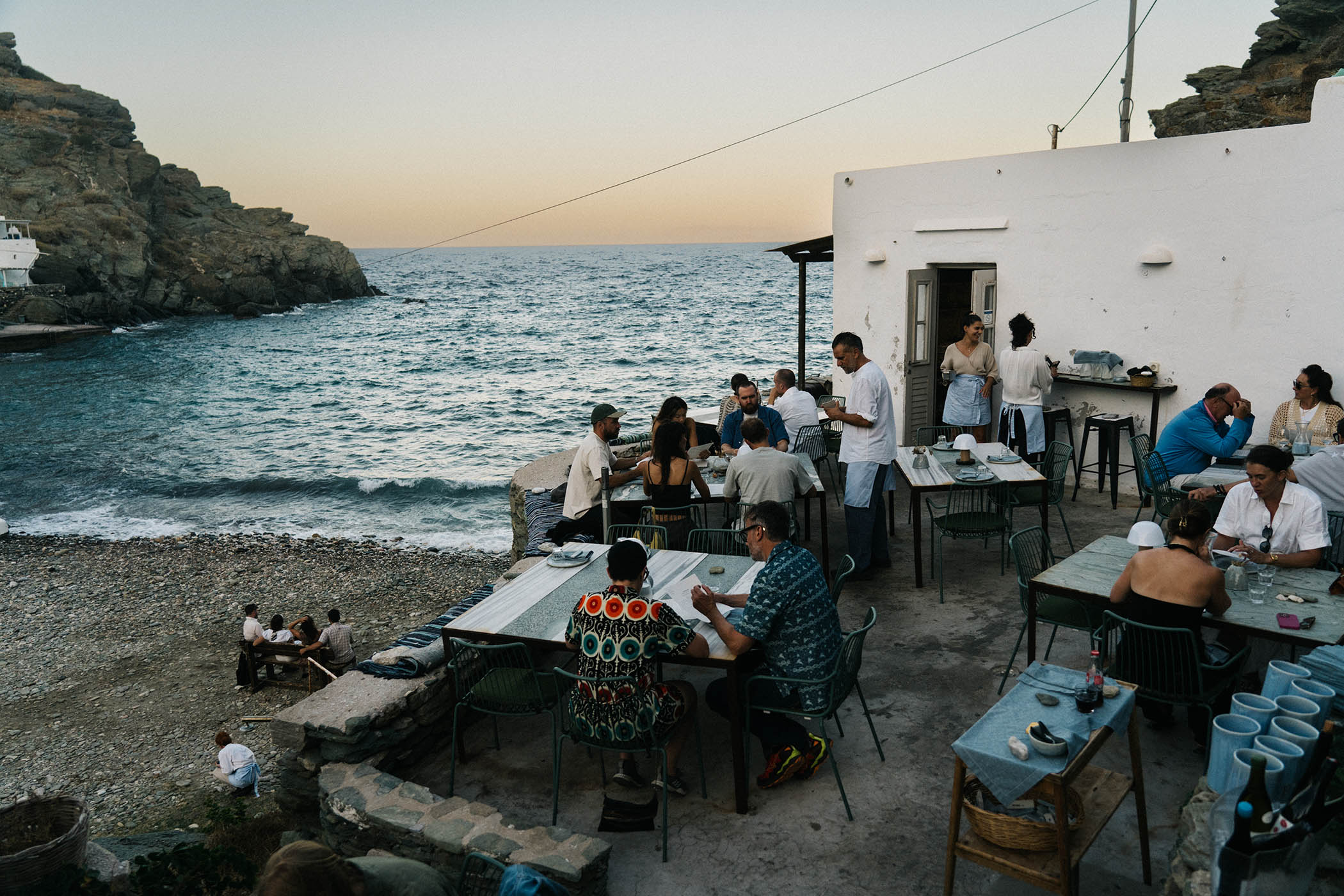
O! Hamos, Milos
The name roughly translates as Oh! Mayhem. While the queue for this no-reservations, farm-to-fork taverna can be frustrating, once you’ve settled onto the seaside terrace with crispy pitarakia (fried cheese pies), roast suckling pig glazed in grape molasses, and hand-rolled pasta with freshly grated tomato, all is forgiven. Oh! Bliss. (+30 22870 21672).
Margarita’s, Anafi
Is it the view, the vibe, or the food that makes this much-loved hangout since the 1980s such a classic? Originally a glorified shack overlooking Klisidi beach, where Margarita served fried eggs with feta to bohemians in swimsuits, the chalkboard menu is still short, simple and features whatever’s growing in Margarita’s garden. Her daughter Effie has elevated the cooking without losing the unpretentious atmosphere (instagram.com/margarita.anafi).
Cantina, Sifnos
Minimal waste, emphatically local, dazzlingly inventive – Cantina makes a virtue of radical simplicity. Seasonal ingredients are smoked, cured and fermented in a tiny stone hut on the pebble cove of Seralia, a setting as wildly exciting as dishes like amberjack dolma with fenugreek sabayon or tomatoes stuffed with rose petal sorbet and basil blossom. (cantinasifnos.gr)
Kali Kardia, Amorgos
Every village on Amorgos still has an old-time kafenio that serves Greek coffee, home-cooked food, and gossip. Some also sell basic provisions or even ferry tickets. Kali Kardia (“The Good Heart”) in Tholaria serves only a handful of dishes, but each one is divine: bite-size meatballs, local lamb in lemon sauce, fava from their own beans (+30 22850 73347).
Matina & Stavros, Naxos
The highlands and plains of Naxos produce the tastiest meat, cheese and potatoes in the Cyclades. Everything at this mountain hideout is grown or reared by the eponymous owners. There’s no menu: every day brings a different array of seasonal vegetables, pies, and stewed or roast lamb, rooster and goat. (+30 22850 51243; facebook.com/matinastaurosplatsa).
Five amazing beaches in the Cyclades. By Heidi Fuller-Love
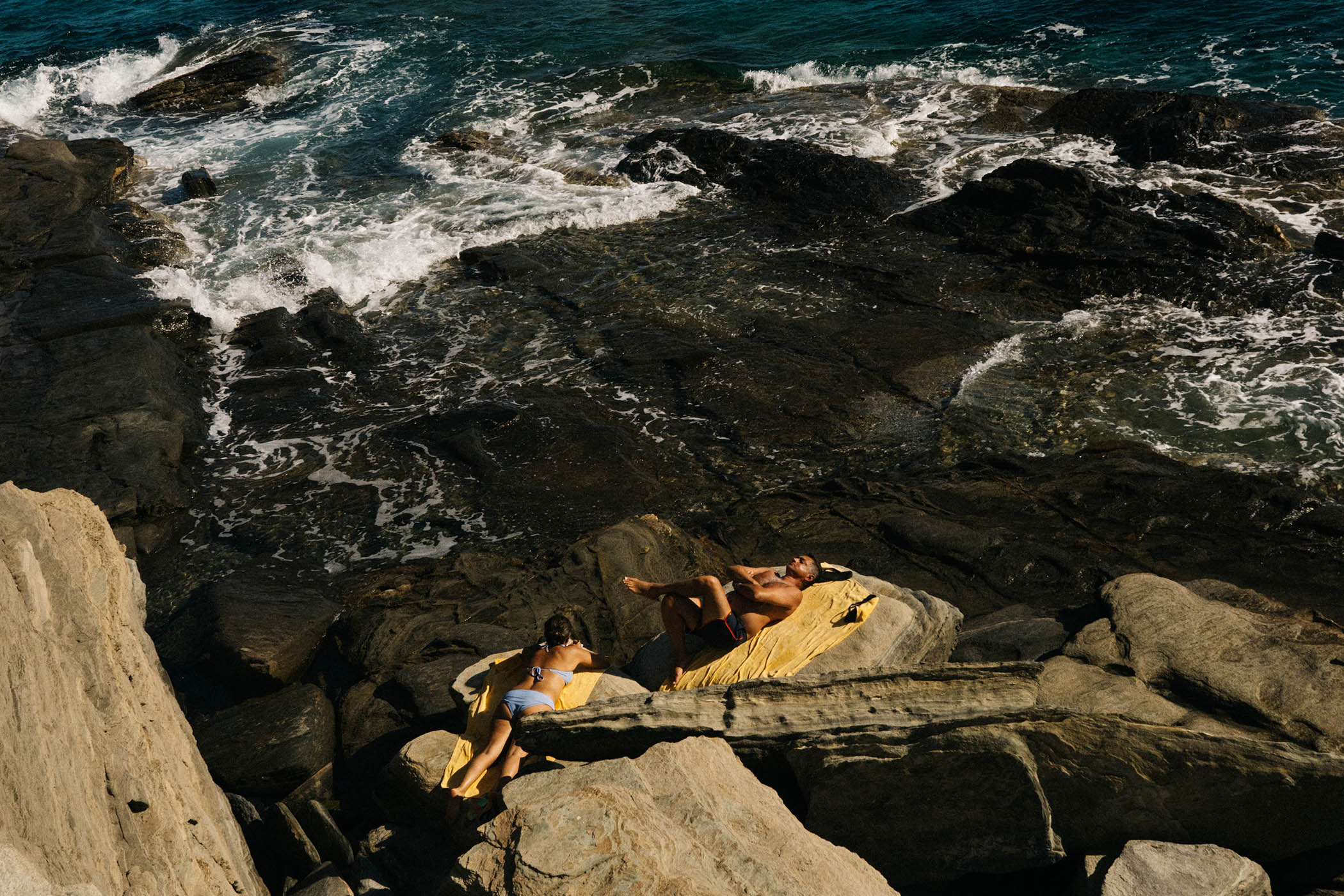
Sarakíniko, Milos
If lunar landscapes are your bag, you’re bound to love splashing about in Sarakíniko’s unique fjord-like coves brimming with translucent turquoise seas, and surrounded by wind-twizzled rocks the colour of mastixa ice cream, on magical Milos Island’s northern coast. You can get there aboard a lumbering KTEL bus in summer, or hire a vintage Vespa and ride there in style.
Kolona, Kythnos
Unsung gem of the glitzy Cyclades, Kythnos is home to one of Greece’s most distinctive beaches. A double arc of golden sand washed by warm shallow waters on either side, this dazzling beach is book-ended by a tiny isle topped by the whitewashed chapel of Agios Loukas – for maximum wow factor, whiz over in a water taxi from Merihas port.
Plaka, Naxos
Silky sand-strewn beaches abound in Naxos, The Cyclades’ largest island, birthplace of lemon-scented liqueur, kitro and home of those mysterious sixth century BC kouroi statues. Reached via a dusty, rutted track and rarely crowded – even at the height of summer – Plaka’s dune-spiked beach slotted between Agios Prokopios’s taverna-lined strand and Mikra Vigla’s breeze-bathed sands, is in a class of its own.
Super Paradise, Mykonos
If you like the idea of shopping and beach hopping in Mykonos, but don’t fancy tackling those madding summer crowds, an off-season break ticks all the boxes. Easily reached from Mykonos Town, Super Paradise’s lick of honeyed sand curved around a shimmering bay really lives up to its name in early October, when skies are still blue but the celebrity-loved beach is near-deserted.
Pori, Pano Koufonisi
You won’t see many tourists on the island of Pano Koufonisi, which belongs to the rarely visited Mikri (smaller) Cyclades, a 40-minute ferry hop from sister island Naxos. Greeks flock to this sliver of land to lounge on Pori, a paradisiacal horseshoe-shaped beach, whose dusky sands surround a vast lagoon of azure waters where you can swim, snorkel, or sunbathe in late summer sun in perfect peace.
Island-hopping shopping in the Cyclades. By Rachel Howard
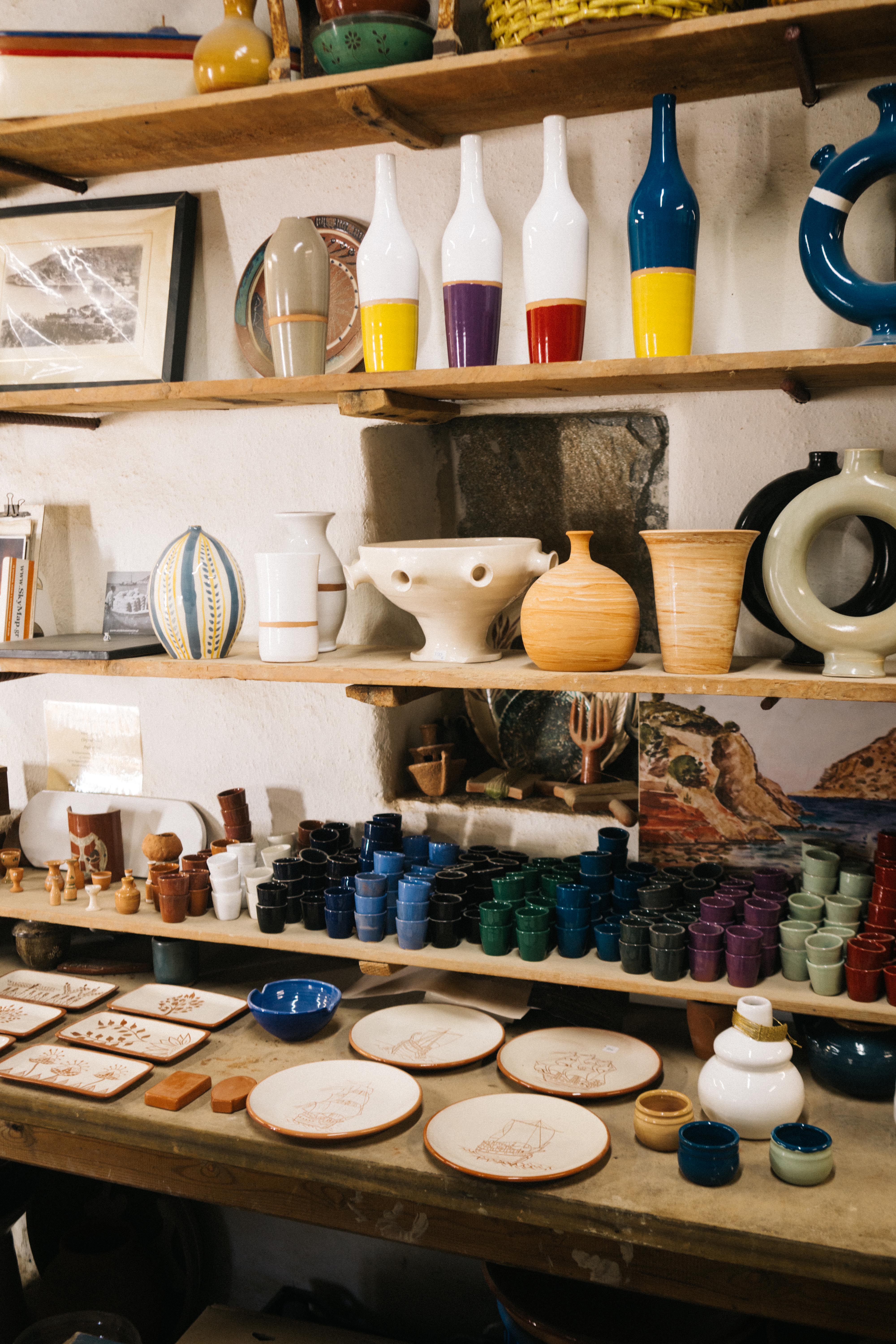
Sifnos is the island for ceramics – the Lembesis family’s bowls and mugs with signature fish and bird motifs, or traditional terracotta plates and jugs, which you can pick up from Atsonios (ceramicartatsonios.gr), will last a lifetime.
On Naxos, Swiss sculptor Tom von Kaenel shapes native white marble into tactile vessels and totems at Kalodromo (kalodromo.ch), an open-air workshop that welcomes visitors by appointment. In the mountain village of Filoti, Theonas (theonasfiloti.com) brims with vintage utensils from tin retsina jugs and brass coffee pots to wicker baskets.
For gourmet goods to fill those baskets and pots, Prekas (prekasyros.gr) on Syros stocks pickled caper leaves, heather honey and nutty, crumbly San Michali cheese. The Agricultural Cooperative on Tinos is another great source of Cycladic cheese, honey and herbs.
On Ios, Theros is a tiny trove of delicate, ethically made jewellery, handmade by Joanna Cave (joannacave.com). For upcycled baubles, embroidered kaftans, handmade leather sandals and striped sarongs, Waikiki brings a splash of colour and pattern to the whitewashed lanes of Chora on Andros.
Colores (colores.gr) on Sifnos work an artisanal aesthetic with its block-print maxi-dresses and jute beach totes – perfect for floating about these windswept isles. Anthologist (anthologist.com) redefines the bland resort boutique with its limited edition paperweights, ceramics, belts and worry beads inspired by ancient Greek art. You’ll find them at Cosme and Parilio hotels on Paros.
